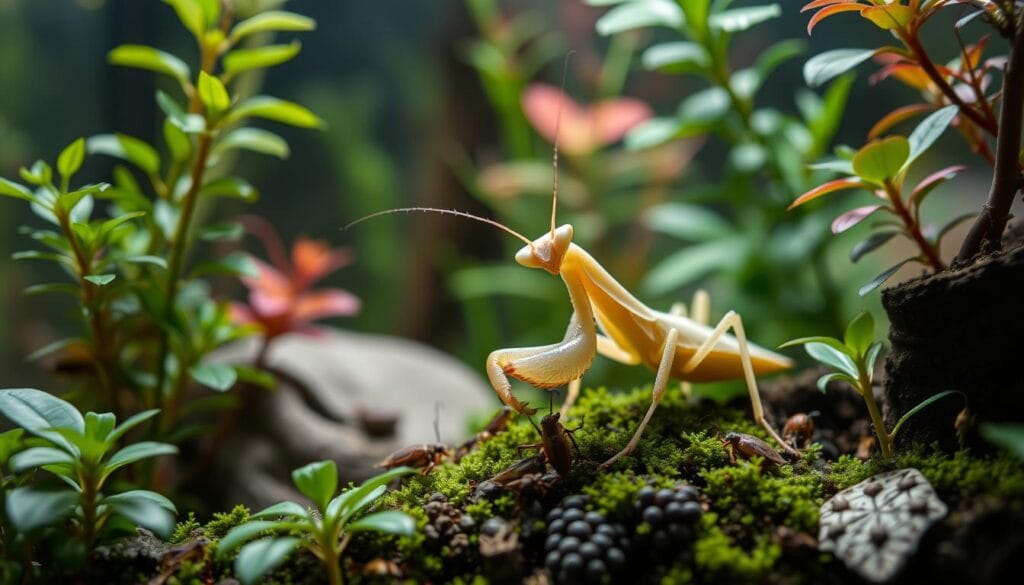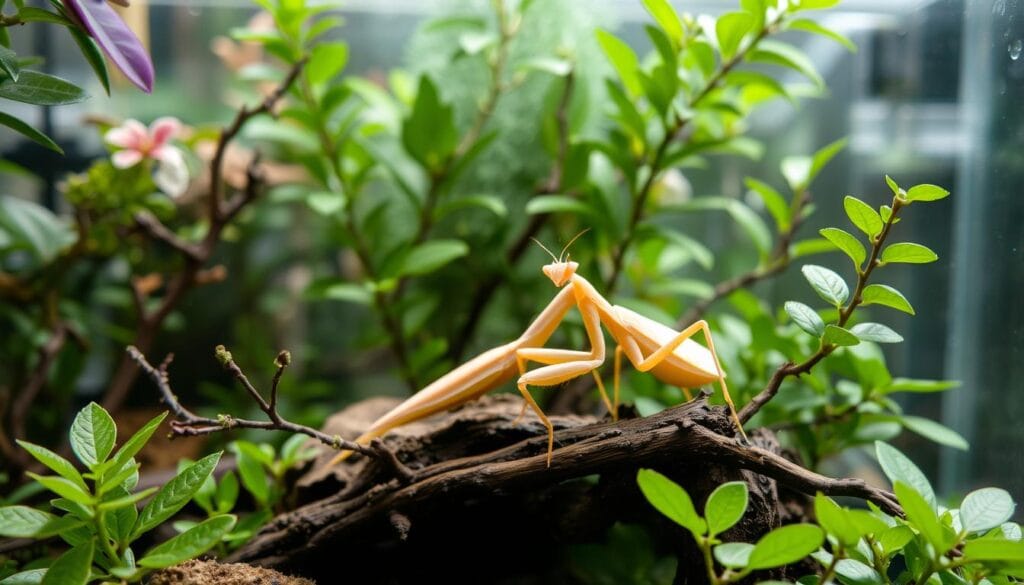When I first saw the ghost mantis, I was amazed by its incredible camouflage. It looked like a tiny leaf, blending into its surroundings perfectly. If you’re thinking of getting one, you’re in for a fascinating adventure.
The ghost mantis (Phyllocrania paradoxa) is truly special. It’s not just an insect; it’s a work of art. These praying mantis species have won the hearts of many with their unique looks and easy care.
Ghost mantises offer a peek into a world of precision and survival. Their amazing camouflage skills make them experts at hiding. They blend into their surroundings like magic.
Table of Contents
Understanding the Ghost Mantis
The ghost mantis is a fascinating insect that shows nature’s amazing camouflage skills. It is a leaf mimic, a cryptic species with unique survival strategies. This makes it one of the most interesting praying mantises in the world.
These creatures have developed amazing adaptations to blend into their surroundings. Their look lets them hide from predators and sneak up on prey.
Origin and Habitat
Ghost mantises come from the dry savannahs and forests of Central and West Africa. They live in tough conditions, perfect for their leaf-mimicking skills.
- Geographic range: Central and West African regions
- Preferred ecosystem: Dry savannahs and forests
- Climate adaptation: Warm temperatures between 20°C and 30°C
Physical Characteristics
The ghost mantis has special features for survival. Its body looks like a dried leaf, with leaf-like parts on its head and legs.
| Characteristic | Details |
|---|---|
| Adult Length | Up to 2 inches |
| Color Variations | Light brown, dark brown, green, black |
| Sexual Dimorphism | Females larger, more leaf-like appendages |
Behavior and Personality
As a cryptic species, the ghost mantis is calm and careful. Their behavioral adaptations are nothing short of extraordinary.
“In the world of camouflage, the ghost mantis is a true master of disguise.” – Entomology Expert
- Movement: Slow and deliberate
- Defense Mechanism: Remain motionless when threatened
- Social Behavior: Can be housed communally with minimal cannibalism risk
Learning about these insects shows the amazing complexity of nature. It highlights how evolution has created perfect survival strategies in tiny creatures.
Setting Up the Perfect Enclosure
Creating a great ghost mantis enclosure needs careful planning. The setup’s quality affects their health and happiness. A good environment should feel like their natural home.
Choosing the Right Container
Choosing the right size is key for a ghost mantis enclosure. Here are some guidelines:
- At least twice as wide as the mantis
- Three times taller than the mantis’s length
- Minimum 1-gallon container for single mantis
- Proper ventilation is essential
Temperature and Humidity Requirements
Ghost mantises need specific conditions to thrive. Keep these parameters in mind for their health:
| Parameter | Ideal Range |
|---|---|
| Temperature | 63-90°F (17-32°C) |
| Humidity | 40-70% |
| Light Cycle | 12-14 hours |
Decorating the Habitat
Make your vivarium a cozy home for your ghost mantis with these tips:
- Use real or artificial plants for climbing
- Include hiding spots for security
- Select substrate materials like:
- Terrarium sand
- Peat moss
- Coco fiber soil
Remember, a well-designed ghost mantis enclosure is key to keeping these delicate creatures healthy and happy!
Feeding Your Ghost Mantis
Knowing what your ghost mantis eats is key to their health. These insects need different foods at different times. This makes feeding them a big part of their care.

Suitable Insect Prey Options
Choose the right insects for your ghost mantis based on their age. The best foods for them are:
- Fruit flies (for younger nymphs)
- Houseflies
- Blue bottle flies
- Small roaches
Feeding Schedule and Quantities
How often you feed your mantis changes as they grow. Young ones need to eat more often. A special feeding plan helps them get the nutrients they need.
| Mantis Stage | Feeding Frequency | Prey Size |
|---|---|---|
| Nymphs (L2-L4) | Every other day | 2-3 tiny fruit flies |
| Sub-Adult | Every 2-3 days | Larger flies |
| Adult | Every 3-4 days | Houseflies, small roaches |
Feeding Best Practices
Your ghost mantis won’t hunt for food. They only catch insects that come close. Always take away any food they don’t eat to keep them healthy. Adding special powders to their diet can also help, as suggested by experts in exotic pet nutrition.
“The key to a healthy ghost mantis is understanding its unique dietary needs and feeding patterns.” – Entomology Expert
Maintaining Health and Wellness
To keep your ghost mantis healthy, you need to pay close attention and take action. These delicate insects require special mantis care techniques to do well in captivity.

Common Health Challenges
Ghost mantis health can face several challenges:
- Dehydration
- Mold growth in enclosure
- Molting difficulties
- Nutritional deficiencies
Recognizing Illness Signs
Look out for these important signs of illness in your ghost mantis:
- Reduced movement or lethargy
- Unusual color changes
- Loss of appetite
- Difficulty molting
Preventative Care Strategies
Keep your ghost mantis well with these key tips:
- Maintain proper humidity levels
- Mist enclosure with spring water
- Clean habitat regularly
- Remove uneaten food promptly
- Provide adequate climbing surfaces
“A healthy ghost mantis is an active and engaged companion that requires dedicated care and attention.”
By following these ghost mantis health practices, you’ll help your insect friend stay vibrant and healthy for its whole life.
Breeding and Life Cycle
Understanding the ghost mantis life cycle is key for successful breeding and care. Ghost mantis breeding starts when adults reach sexual maturity, usually two weeks after their last molt. Female ghost mantises are bigger than males and are vital for reproduction.
The life cycle of ghost mantises has several stages. After mating, females lay oothecae (egg cases) that can hold up to three dozen young. These egg cases are placed in warm, humid spots with temperatures between 75-80°F. The ootheca keeps the eggs safe, and they hatch in 2-4 weeks after being laid.
Nymphs come out looking like tiny adult ghost mantises and need special care. They eat small insects and prefer higher humidity than adults. To stop them from eating each other, keep nymphs apart as they go through seven stages. From nymph to adult, it takes about 8 weeks.
To breed ghost mantises successfully, keep the temperature and humidity steady. Make sure well-fed females have a calm place to breed. With the right care, you can watch these amazing insects grow from start to finish.


At this moment I am going away to do my breakfast, once
having my breakfast coming over again to read
additional news.